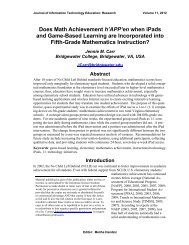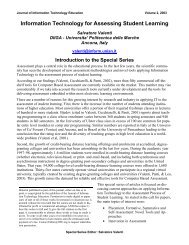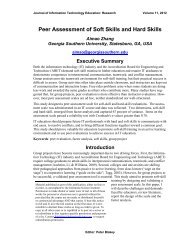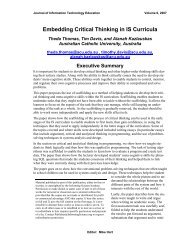Collaborative Learning in Online Study Groups - Journal of ...
Collaborative Learning in Online Study Groups - Journal of ...
Collaborative Learning in Online Study Groups - Journal of ...
Create successful ePaper yourself
Turn your PDF publications into a flip-book with our unique Google optimized e-Paper software.
<strong>Collaborative</strong> <strong>Learn<strong>in</strong>g</strong> <strong>in</strong> Onl<strong>in</strong>e <strong>Study</strong> <strong>Groups</strong>: An EGT Perspective<br />
In view <strong>of</strong> the above mentioned issues, standard game theory approaches have been extended by<br />
add<strong>in</strong>g evolution as a new dimension (i.e., “evolutionary” game theory or EGT) thereby dropp<strong>in</strong>g<br />
the unrealistic assumption <strong>of</strong> rationality. To this end, the concepts <strong>of</strong> population <strong>of</strong> players and<br />
<strong>in</strong>terpretation <strong>of</strong> pay<strong>of</strong>f as fitness have been considered, which naturally lead to a dynamical approach<br />
(Cressman, 2003; G<strong>in</strong>tis, 2000; H<strong>of</strong>bauer & Sigmund, 1998; Nowak, 2006a; Weibull,<br />
1995). Orig<strong>in</strong>at<strong>in</strong>g from the work <strong>of</strong> Maynard Smith and Price (1973), the fundamental idea <strong>of</strong><br />
EGT is that evolution takes part <strong>in</strong> spread<strong>in</strong>g the successful strategies/traits <strong>in</strong> the population.<br />
Such a process is done via frequency-dependent selection, which means the spread <strong>of</strong> a particular<br />
strategy/trait depends on the relative abundances <strong>of</strong> the types <strong>of</strong> players <strong>in</strong> the population.<br />
Boosted by the sem<strong>in</strong>al books <strong>of</strong> Maynard Smith (1982) and Axelrod (1984), EGT has been used<br />
extensively as a standard tool for understand<strong>in</strong>g the emergence and ma<strong>in</strong>tenance <strong>of</strong> cooperation.<br />
Based on the development and study <strong>of</strong> different social dilemma games over the past few decades,<br />
several mechanisms that encourage cooperative behaviour with<strong>in</strong> the general EGT framework<br />
have been identified. Nowak (2006b) reviewed and summarised five <strong>of</strong> the most relevant<br />
mechanisms as follows: k<strong>in</strong> selection, direct reciprocity, <strong>in</strong>direct reciprocity, network reciprocity<br />
(which is also a generalisation <strong>of</strong> spatial reciprocity), and group selection.<br />
Among these mechanisms, one <strong>of</strong> the most important themes is the existence <strong>of</strong> group structures<br />
<strong>in</strong> the population (e.g., network/spatial reciprocity, group selection, or, to some extent, k<strong>in</strong> selection).<br />
Numerous studies <strong>in</strong> the EGT literature have demonstrated that by restrict<strong>in</strong>g the <strong>in</strong>teractions<br />
<strong>of</strong> players to local neighbourhoods/groups (Chiong, Dhakal, & Jankovic, 2007; Chiong &<br />
Kirley, 2009, 2011, 2012a; Kill<strong>in</strong>gback & Doebeli, 1996; Nowak & May, 1992, 1993) or subdivid<strong>in</strong>g<br />
the population <strong>in</strong>to groups (Kill<strong>in</strong>gback, Bieri, & Flatt,, 2006; Nunney, 1985; Traulsen &<br />
Nowak, 2006; Wilson 1990), cooperative behaviour can be promoted. Motivated by this, we hope<br />
to apply pr<strong>in</strong>ciples and f<strong>in</strong>d<strong>in</strong>gs from EGT to address issues <strong>in</strong> onl<strong>in</strong>e study groups.<br />
<strong>Collaborative</strong> <strong>Learn<strong>in</strong>g</strong> <strong>in</strong> Onl<strong>in</strong>e <strong>Groups</strong><br />
The <strong>in</strong>itial research f<strong>in</strong>d<strong>in</strong>gs related to onl<strong>in</strong>e group work were predom<strong>in</strong>antly optimistic (e.g., see<br />
McConnell, 2000; Stacey, 1999). This optimism stemmed largely from high expectations about<br />
the tools that Web-based learn<strong>in</strong>g platforms could <strong>of</strong>fer for onl<strong>in</strong>e collaborative learn<strong>in</strong>g (Jones &<br />
Steeples, 2002). More recent studies have shown, however, that while the technology does provide<br />
a solid platform for onl<strong>in</strong>e collaboration, it does not guarantee successful learn<strong>in</strong>g (Laurillard,<br />
2002). Accord<strong>in</strong>gly, a number <strong>of</strong> research studies were conducted with the aim <strong>of</strong> identify<strong>in</strong>g<br />
the factors that <strong>in</strong>fluence (either positively or negatively) the success <strong>of</strong> collaboration <strong>in</strong><br />
onl<strong>in</strong>e study groups. In this section, we summarise the most important f<strong>in</strong>d<strong>in</strong>gs <strong>of</strong> those research<br />
studies.<br />
One research stream explored students’ perceptions about the benefits <strong>of</strong> onl<strong>in</strong>e group work as<br />
well as the problems they experienced while study<strong>in</strong>g as members <strong>of</strong> onl<strong>in</strong>e learn<strong>in</strong>g groups. For<br />
example, Ellis (2001) reported the follow<strong>in</strong>g positive aspects <strong>of</strong> onl<strong>in</strong>e collaborative work: 1) access<br />
to peer knowledge, 2) availability <strong>of</strong> other students to provide feedback, 3) ability to access<br />
the technology at one’s convenience, and 4) an opportunity to reflect on the exchanged messages.<br />
Gabriel (2004) reported that the students participat<strong>in</strong>g <strong>in</strong> her study developed an understand<strong>in</strong>g <strong>of</strong><br />
the recursive nature <strong>of</strong> knowledge construction (review, reth<strong>in</strong>k, and revise one’s work) and an<br />
<strong>in</strong>creas<strong>in</strong>g belief <strong>in</strong> their own ability to learn efficiently <strong>in</strong> the onl<strong>in</strong>e group environment (i.e.,<br />
their perception <strong>of</strong> self-efficacy <strong>in</strong>creased as the course progressed).<br />
Researchers also reported on the identified weaknesses and challenges <strong>of</strong> onl<strong>in</strong>e collaborative<br />
work. For <strong>in</strong>stance, Stodel, Thompson, and MacDonald (2006) identified five themes regard<strong>in</strong>g<br />
what learners perceived were miss<strong>in</strong>g from their onl<strong>in</strong>e learn<strong>in</strong>g experience, namely, robustness<br />
<strong>of</strong> onl<strong>in</strong>e dialogue, spontaneity and improvisation, perceiv<strong>in</strong>g and be<strong>in</strong>g perceived by the other,<br />
84










